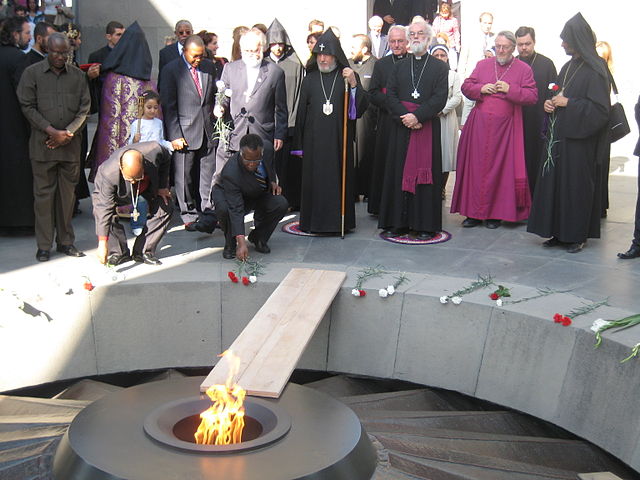From Wikipedia, the free encyclopedia
Tsitsernakaberd is the official memorial to the Armenian genocide victims in Yerevan, Armenia. It was opened in 1967 after a mass demonstration that took place in Yerevan on April 24, 1965, on the 50th anniversary of the deportation of hundreds of Armenian intellectuals from Constantinople that marked the beginning of the genocide.[1][2] After Armenia's independence from the Soviet Union in 1991, the memorial became a part of official ceremonies. Since then, almost every foreign official who visited Armenia included a visit to the memorial to pay tribute to the victims of the genocide.[3] A visit to Tsitsernakaberd often includes a tour in the nearby museum. Some notable visitors have planted trees at the memorial.


A wide range of politicians, artists, musicians, athletes, and religious figures have visited the memorial. The most notable ones include Presidents of Russia (Boris Yeltsin, Vladimir Putin, Dmitry Medvedev), France (Jacques Chirac, Nicolas Sarkozy, François Hollande), Ukraine, Czech Republic, Poland, Greece, Georgia, Iran, Belarus, Romania, Lebanon, Croatia, Serbia, and Prime Ministers of Bulgaria, Czech Republic and other countries. Foreign Ministers of many countries (including US Secretary of State Hillary Clinton and several high-ranking officials of the European Union — including José Manuel Barroso and Herman Van Rompuy) — have honored the victims by visiting Tsitsernakaberd. Other visitors include Pope John Paul II in 2001, Pope Francis in 2016, the Chief Rabbi of Israel Yona Metzger, the Primate of All England Rowan Williams, the Patriarch of the Russian Orthodox Church Kirill I of Moscow, World Chess champion Vladimir Kramnik, World football champion Youri Djorkaeff, English rock star Ian Gillan, Serbian filmmaker Emir Kusturica, French actors Gérard Depardieu and Alain Delon, Nobel Prize winner in Physics Zhores Alferov.
No current Turkish state official has visited Tsitsernakaberd.
Armenian genocide recognition is one of the most important foreign policy issues of Armenia, and is the number one goal of the diaspora Armenian organizations. Many Armenians look at these visits as a sign of recognition of the genocide.[4]
O Judge of the living and the dead, have mercy on us!
Listen, O Lord, to the lament that rises from this place,
to the call of the dead from the depths of the Metz Yeghérn,
the cry of innocent blood that pleads like the blood of Abel,
like Rachel weeping for her children because they are no more.
Pope John Paul II arrived in Yerevan on September 25, 2001, to participate in the celebrations of 1,700th anniversary of the adoption of Christianity as the national religion of Armenia.[7] The Pope visited the memorial the next day after meeting with President Robert Kocharyan. He laid a wreath for the victims of the genocide, made a short speech, and read a prayer.[8][9] The Pope used the term Metz Yeghern (the Armenian word for genocide, which literally translates as "Great Crime") in his prayer, causing a controversy regarding whether he recognized the events of 1915 as a genocide or not.[10][11] Nevertheless, it aroused a wave of discontent in Turkey.[12]
U.S. Secretary of State Hillary Clinton arrived in Yerevan on July 4, 2010, on America's independence day, thus becoming the highest-ranked American official to visit the country. Her visit was considered "to be symbolic but nonetheless significant" and her possible visit to Tsitsernakaberd became a subject of much discussion in the Armenian media. The United States had not yet recognized the Armenian Genocide officially and by visiting the genocide memorial, many thought that by her visit, the United States sent a clear political message to Turkey.[13] She visited the memorial on July 5, before leaving for Tbilisi. The wreath that Clinton laid at the memorial read "From Secretary of State Hillary Rodham Clinton" although it was first announced that her visit would be non-official.[14]
Abdulla Shahid, President of the United Nations General Assembly, visited the memorial and the museum on July 27, 2022, and posted pictures of the visit to Twitter, however he later deleted the post.[15][16] Turkey's Foreign Ministry stated that Shahid's visit "has been exploited with the purpose of exposing one-sided Armenian claims and it is in that context that he paid a visit to the so-called genocide memorial." Turkey said Shahid "would have been expected to act in a fair and impartial manner, to be more careful and responsible in this regard."[17]
Turkish President Abdullah Gül visited Armenia in September 2008 to attend a football match between the Armenian and Turkish national teams in Yerevan. Since the Turkish government denies the fact of genocide, he did not visit the memorial.[18] Other presidents who opted not to pay a visit to Tsitsernakaberd were Syrian President Bashar al-Assad and Iranian Mahmoud Ahmadinejad.[19] They refused to visit the memorial so as not to compromise their bilateral relationship with neighboring Turkey.[20][21]
In 2010, Mevlüt Çavuşoğlu, the Turkish President of the Parliamentary Assembly of the Council of Europe (PACE), refused to visit the memorial stating, "it is my own decision. I respect your opinion and you should respect mine."[22]
| External videos | |
|---|---|
| Hillary Clinton's visit in 2010 | |
| Nicolas Sarkozy at the memorial, 2011 |


Seamless Wikipedia browsing. On steroids.